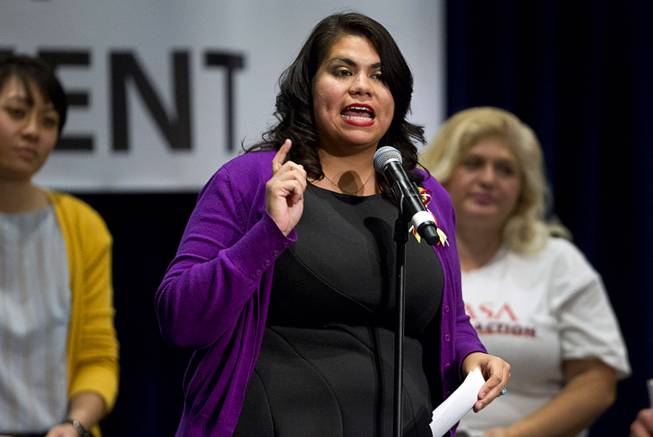
Dreamer Astrid Silva speaks during the Fair Immigration Reform Movement (FIRM) Presidential Candidate Forum at the Linq Sunday, Nov. 8, 2015.
Wednesday, Aug. 1, 2018 | 2 a.m.
Astrid Silva, one of Nevada’s most outspoken immigrant rights activists, has called Nevada home since she was 5 years old. A year before, a 4-year-old Silva migrated with her parents from Mexico to the U.S.
For years, she and thousands of others brought here as children from other countries have grown up uncertain and unable to plan for their futures, dreaming of a pathway to citizenship in the U.S.
They’ve been dreaming since Aug. 1, 2001 — 17 years ago today. That’s when Sen. Orrin Hatch, R-Utah, introduced the Development, Relief and Education For Alien Minors (DREAM) Act, which would offer a pathway to citizenship for undocumented children brought to the U.S.
For 17 years, different versions of the DREAM Act have been introduced in Congress, most recently in 2017. But no iterations of the act have passed.
Now, many of the children whom the first bill would have covered have “aged-out” or turned 31, the age limit for protection under the DREAM Act.
“When the DREAM Act was first introduced, I was 11 years old. I had no idea what it was, what it would do for me, and I didn’t even know I was a person who would benefit from it,” Silva said. “Now, I’m getting close to the age where in the original DREAM Act, the versions that have come up, I am getting close to the cutoffs.”
In 2011, then-Senate Majority Leader Harry Reid, D-Nev., reintroduced the DREAM Act on the Senate floor. It didn’t pass.
But shortly after, in 2012, the Obama Administration enacted the Deferred Action for Childhood Arrivals — DACA — program that offered protection to almost 800,000 so-called Dreamers, including Silva.
Silva is now 30, and the future of DACA is uncertain after the Trump administration announced it would end the program in September 2017, phasing it out over six months.
While three different courts have ruled the administration must keep the program, on Aug. 8, a Texas federal judge could issue a ruling that would lead U.S. Citizenship and Immigration Services to stop accepting new and renewed DACA applications.
Thousands of people are depending upon the passage of the DREAM Act to remain in the United States if DACA ends. The end of DACA would extend beyond the individuals covered by the program, impacting their families and communities.
Briceida Castro comes from mixed-status family. She is an American citizen and her brother is a permanent resident, but her sister is a DACA recipient who teaches special education in the Clark County School District.
Castro’s sister is one of nearly 702,250 active DACA recipients, according to U.S. Citizenship and Immigration Services.
“This is something I’ve always grown up with. I’ve always known the status of my family,” Castro said.
Castro said she remembers the day the DREAM Act was first introduced. “I remember just knowing my siblings were going to be able to do more,” she said. “Even though I’m not personally affected by the DREAM Act or being a DACA recipient, it’s my sister.”
Juan Escalante, a Dreamer and communications director for the immigration reform group America’s Voice, was 11 when he migrated from Venezuela to the U.S. with his family in August 2000. Escalante, the oldest of three children, has been active in advocating for the DREAM Act since 2007.
Escalante’s goal wants people to realize that the DREAM Act is not an amnesty bill but a way to help thousands of people like him, Silva and Castro’s sister to work towards citizenship.
“At the end of the day, here we are 17 years since the bill was first introduced and, unfortunately, Congress still debates,” Escalante said. “We’re talking about students, veterans. We’re talking about people who are essentially Americans in every single sense but on paper and yet Congress refuses to find a way to solidify our immigration status, even though we grew up here, went to school here and pledge allegiance to the flag like anybody else does.”
